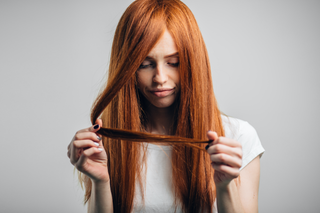Does it seem like no matter what you try, nothing works on your hair? Does it stay tangled, frizzy, dry, or covered in buildup no matter what you do? The porosity of your hair may be to blame. Here are five signs you may have low porosity hair.
Your Hair Takes a Long Time to Get Wet
When you wash your hair, does it take ages to get wet? Or do you always have to wash your hair twice because it’s only really wet after you’ve finished the first wash? You may have low porosity hair.
Low porosity hair has cuticles that fit tightly together, making it difficult for water to penetrate the hair shaft. Your hair is a fortress. Nothing comes in. Nothing gets out. The silver lining is that when you do finally get some moisture into your strands, it’s not lost easily.
Your Hair Takes Forever to Dry
If your hair takes ages to get wet, it also feels like it takes an eternity to dry. And that can be particularly problematic when you want to air dry your hair.
Since the cuticles in low porosity hair tend to remain closed, water simply stays on the surface. Whereas high-porosity hair would absorb water and dry quickly, your hair simply stays wet. For a very, very long time.
You Get Tons of Buildup
What you put on your hair stays on your hair. Because low porosity hair doesn’t readily absorb anything, all the products you use build up on the surface.
If you’ve been trying everything to make your hair more manageable, but it always seems to be dull, greasy, or stiff instead, you may have low porosity hair. It’s not impossible to use products if you have low porosity hair. You just need to choose products that work well and use smaller amounts.
Protein Treatments Make Your Hair Stiff
Have you ever tried using a keratin treatment, expecting smooth, shiny hair, only to be left with a stiff, crunchy mess? That’s due to low porosity hair.
Since your hair won’t allow the treatment to penetrate the hair shaft, the protein builds up on your hair instead. This causes it to become stiff and makes it even more difficult for your hair to absorb moisture.
Your Hair Floats
The simplest way to test the porosity of your hair is by performing a float test. Take a strand of clean hair and drop it into a cup of room-temperature water.
If your hair floats on the surface, you have low-porosity hair. If it sinks slowly to the bottom, you have medium porosity. And if it sinks quickly to the bottom, you have high-porosity hair. Hair with low porosity floats because it doesn’t absorb the water it’s sitting in.

